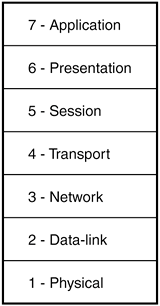OSI Seven Layer Model
| As shown in Figure 4.1, the OSI reference model is built, bottom to top, in the following order: physical, data-link, network, transport, session, presentation, and application. The physical layer is classified as layer 1 and the top layer of the model, the application layer, as layer 7. Figure 4.1. The OSI seven layer model.
Each layer of the OSI model has a specific function. The following sections describe the function of each layer, starting with the physical layer and working up the model. Physical Layer (Layer 1)The physical layer of the OSI model identifies the physical characteristics of the network, including the following specifications:
In addition to these, the physical layer also defines the voltage used on a given media and the frequency at which the signals that carry the data move from one state to another. These characteristics dictate the speed and bandwidth of a given media as well as the maximum distance over which a certain media type can be used. Data-link Layer (Layer 2)The data-link layer is responsible for getting data to the physical layer so that it can be transmitted over the network. The data-link layer is also responsible for error detection, error correction, and hardware addressing. The term frame is used to describe the logical grouping of data at the data-link layer. The data-link layer has two distinct sublayersthe Media Access Control (MAC) sublayer and the Logical Link Control (LLC) sublayer.
Network Layer (Layer 3)The primary responsibility of the network layer is routingproviding mechanisms by which data can be passed from one network system to another. It does not specify how the data is passed, but rather provides the mechanisms to do so. Functionality at the network layer is provided through protocols, which are software components. Protocols at the network layer are also responsible for route selection, which refers to determining the best path for the data to take throughout the network. In contrast to the data-link layer, which uses MAC addresses to communicate on the LAN, network protocols use software configured addresses and special routing protocols to communicate on the network. The term packet is used to describe the logical grouping of data at the data-link layer.
Transport Layer (Layer 4)The basic function of the transport layer is to provide mechanisms to transport data between network devices. Primarily it does this in three ways:
Protocols at the Transport LayerProtocols that operate at the transport layer can either be connectionless, such as the User Datagram Protocol (UDP) , or connection oriented, such as Transmission Control Protocol (TCP). For a further discussion of these protocols, and of the difference between connection oriented and connectionless protocols, refer to the information on network protocols later in this chapter. Flow ControlThe transport layer is also responsible for data flow control, which refers to the way in which the receiving device can accept data transmissions. There are two common methods of flow control used, buffering and windowing:
Session Layer (Layer 5)The session layer is responsible for managing and controlling the synchronization of data between applications on two devices. It does this by establishing, maintaining, and breaking sessions. Whereas the transport layer is responsible for setting up and maintaining the connection between the two nodes, the session layer performs the same function on behalf of the application. Presentation Layer (Layer 6)The presentation layer's basic function is to convert the data intended for or received from the application layer into another format. Such conversion is necessary because of the way in which data is formatted, so it can be transported across the network. This conversion is not necessarily readable by applications. Some common data formats handled by the presentation layer include the following:
Another very important function of the presentation layer is encryption, which is the scrambling of data so that it can't be read by anyone other than the intended recipient. Given the basic role of the presentation layerthat of data-format translatorit is the obvious place for encryption and decryption to take place. Application Layer (Layer 7)In simple terms, the function of the application layer is to take requests and data from the users and pass them to the lower layers of the OSI model. Incoming information is passed to the application layer, which then displays the information to the users. Some of the most basic application-layer services include file and print capabilities. The most common misconception about the application layer is that it represents applications that are used on a system such as a Web browser, word processor, or a spreadsheet. Instead, the application layer defines the processes that enable applications to use network services. For example, if an application needs to open a file from a network drive, the functionality is provided by components that reside at the application layer. |
